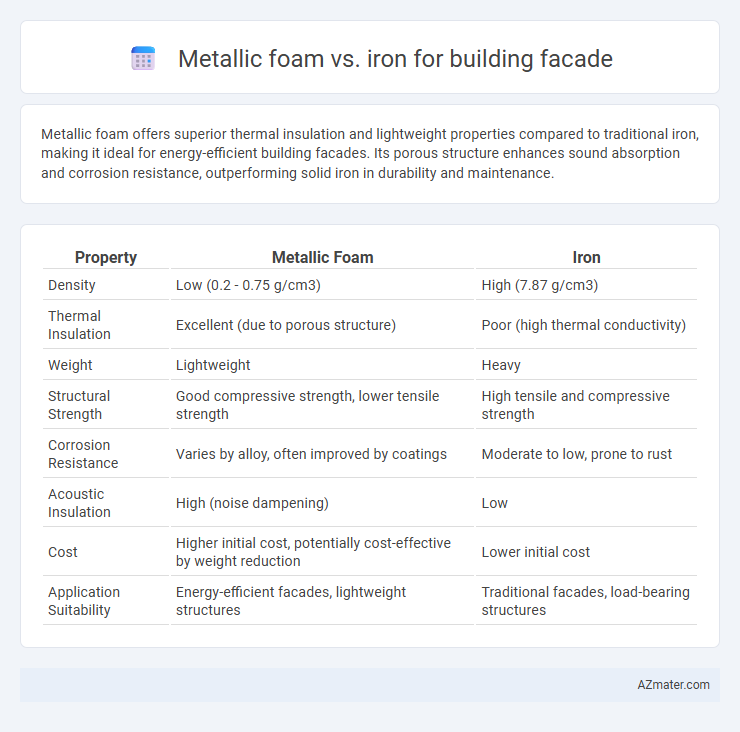Metallic foam offers superior thermal insulation and lightweight properties compared to traditional iron, making it ideal for energy-efficient building facades. Its porous structure enhances sound absorption and corrosion resistance, outperforming solid iron in durability and maintenance.
Table of Comparison
| Property | Metallic Foam | Iron |
|---|---|---|
| Density | Low (0.2 - 0.75 g/cm3) | High (7.87 g/cm3) |
| Thermal Insulation | Excellent (due to porous structure) | Poor (high thermal conductivity) |
| Weight | Lightweight | Heavy |
| Structural Strength | Good compressive strength, lower tensile strength | High tensile and compressive strength |
| Corrosion Resistance | Varies by alloy, often improved by coatings | Moderate to low, prone to rust |
| Acoustic Insulation | High (noise dampening) | Low |
| Cost | Higher initial cost, potentially cost-effective by weight reduction | Lower initial cost |
| Application Suitability | Energy-efficient facades, lightweight structures | Traditional facades, load-bearing structures |
Introduction to Building Facade Materials
Metallic foam offers a lightweight, high-strength alternative to traditional iron for building facades, enhancing thermal insulation and acoustic performance. Iron provides superior structural durability and weather resistance but is heavier and less energy-efficient compared to metallic foam. Choosing between these materials depends on balancing load-bearing requirements with energy-saving goals and aesthetic preferences.
What is Metallic Foam?
Metallic foam is a lightweight structure composed of metal with gas-filled pores, offering high strength-to-weight ratios and excellent thermal insulation properties compared to traditional iron. In building facades, metallic foam provides enhanced energy efficiency, corrosion resistance, and acoustic dampening, making it a superior alternative to solid iron panels. Its porous nature significantly reduces material weight while maintaining structural integrity, contributing to sustainable and innovative architectural designs.
Overview of Iron as a Facade Material
Iron as a facade material offers exceptional strength and durability, making it suitable for structural and decorative purposes in building exteriors. It provides excellent resistance to weathering and can be treated with various coatings to prevent corrosion, ensuring long-term performance. Iron's malleability allows for intricate designs, while its thermal mass contributes to energy efficiency in facade systems.
Aesthetic Differences: Metallic Foam vs Iron
Metallic foam offers a unique, lightweight texture with a porous, sculptural appearance that enhances modern architectural aesthetics, contrasting sharply with iron's solid, dense, and industrial look. The reflective surface of metallic foam creates dynamic light interactions and depth, while iron provides a traditional, robust facade with a uniform matte or weathered surface. These aesthetic differences impact design choices by enabling more creative, organic forms with metallic foam, whereas iron emphasizes strength and timelessness.
Weight and Structural Implications
Metallic foam offers significantly lower density compared to traditional iron, reducing the overall weight of building facades and easing structural load demands. Its porous structure provides excellent energy absorption and thermal insulation properties while maintaining sufficient strength for facade applications. Using metallic foam can lead to lighter support frameworks and potentially lower construction costs without compromising durability or safety.
Thermal and Acoustic Insulation Properties
Metallic foam offers superior thermal insulation for building facades due to its porous structure, significantly reducing heat transfer compared to traditional iron panels. Its cellular composition also enhances acoustic insulation by effectively absorbing and dampening sound waves, minimizing noise pollution in urban environments. Iron, while durable and strong, lacks the intrinsic insulating properties of metallic foam, making it less effective for energy-efficient and noise-reducing facade applications.
Corrosion Resistance and Durability
Metallic foam offers superior corrosion resistance compared to traditional iron due to its porous structure treated with protective coatings that minimize oxidation. This enhanced resistance contributes to greater durability in harsh environmental conditions, reducing maintenance needs and extending facade lifespan. Iron, while strong, is prone to rust and structural degradation without regular protective treatments, making metallic foam a more resilient choice for building facades.
Sustainability and Environmental Impact
Metallic foam offers superior sustainability for building facades by providing lightweight durability that reduces structural load and material usage, resulting in lower carbon emissions during construction. Its high recyclability and potential for energy absorption contribute to minimizing environmental impact compared to traditional iron, which demands intensive mining and processing with significant CO2 output. Using metallic foam enhances thermal insulation and reduces energy consumption, supporting green building certifications and long-term ecological benefits.
Cost Considerations and Long-Term Value
Metallic foam offers a higher initial cost compared to traditional iron for building facades due to its complex manufacturing process and lightweight, porous structure. However, its superior thermal insulation, corrosion resistance, and reduced maintenance expenses contribute to significant long-term value and energy savings. Iron facades, while initially more affordable, often incur higher lifecycle costs related to rust prevention, repairs, and heavier structural support requirements.
Choosing the Right Material: Key Factors and Recommendations
Metallic foam offers superior thermal insulation and lightweight properties compared to traditional iron, making it ideal for energy-efficient building facades. Iron provides exceptional structural strength and durability but is heavier and more prone to corrosion without proper treatment. When selecting facade materials, prioritize factors such as load-bearing requirements, environmental exposure, maintenance needs, and thermal performance to determine the best fit.

Infographic: Metallic foam vs Iron for Building facade
 azmater.com
azmater.com